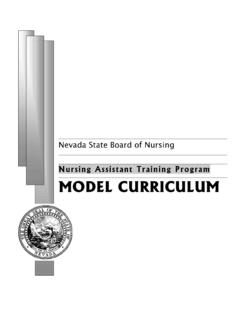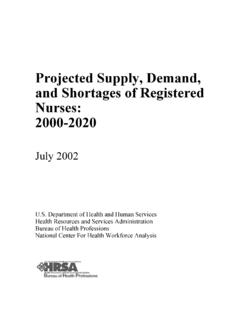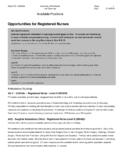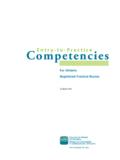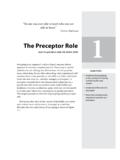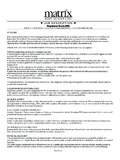Transcription of Opiod prescribing guidelines Nov 2016 - Nevada State …
1 1 November 2016 Nevada Opioid prescribing guidelines for Advanced Practice registered Nurses The following guidelines have been adopted by the Nevada State Board of Nursing in order to promote best practices for prescribing opioids for acute pain (short term pain that resolves when the trauma or surgery resolves) and chronic pain (pain lasting months to years). These guidelines are an educational tool. Prescribers should use their own clinical judgement and not base clinical decisions solely on these guidelines . These guidelines are not meant for the treatment patients receiving hospice care, or the treatment of pain and symptom management at the end of life or cancer pain. An Advanced Practice registered nurse (APRN) who has the requisite licensure, skill, training and education may prescribe, order, administer or dispense an opioid to treat acute, chronic or intractable pain only for a legitimate medical purpose based upon accepted scientific knowledge of the treatment of such pain and sound clinical grounds relating to the unique condition and circumstances of the patient.
2 Specific education related to safe prescribing practices and the identification of possible substance use disorders is greatly encouraged. The APRN should document in the medical record of the patient all actions taken by the APRN to comply with the guidelines . Determining when to initiate opioids for acute pain should include the following: o A traditional clinical and pain-specific history that includes inquiry into the patient s prescription and illicit drug, alcohol, marijuana and tobacco use; o A physical examination that is both comprehensive and pain specific including a patient self rating of pain severity score; o A review of the prescription drug monitoring program (PMP); o The APRN must consider all non-opioid treatments that could, in the professional judgement of the APRN, possibly be used to treat the acute pain; o If in the professional judgement of the APRN, an opioid is the appropriate treatment for the acute pain, the lowest effective dose should be prescribed and for no longer than the expected duration of the acute pain.
3 O Long-lasting or extended-release opioids should not be prescribed to treat acute pain unless the APRN determines, based upon the needs of the particular patient, that there is a clinical reason that a long-lasting or extended-release opioid is necessary to treat the acute pain. Such determination and rationale should be documented in the medical record; and o Information regarding safe storage and disposal of unused opioid medication should be provided to the patient. 2 Determining when to initiate or continue opioids for chronic pain should include the following: o Nonpharmacologic therapy and nonopioid pharmacologic therapy are preferred for chronic pain. The APRN should only consider opioid therapy if the expected benefits for both pain and function are anticipated to outweigh risks to the patient; o A traditional clinical and pain-specific history that includes inquiry into the patient s prescription and illicit drug, alcohol, marijuana and tobacco use; o A physical examination that is both comprehensive and pain specific including a patient self rating of pain severity score which is consistently used during each visit; o A review of the prescription drug monitoring program (PMP); o A baseline urine drug test; o An opioid misuse risk tool evaluation (ORT Opioid Risk Tool, SOAPP Screener and Opioid Assessment for Patients with Pain, or other published validated, evidence based tool).
4 A discussion with the patient about the results and any mitigation strategies implemented as a result of the score; o A benefit versus risk assessment and discussion with the patient should be conducted and documented in the medical record. Realistic treatment goals for pain and function should be established including consideration of how opioid therapy will be discontinued if unsuccessful; o An informed consent form signed by both the patient and the APRN detailing medication, benefits, risks, and expected outcomes of treatment. Informed consent should be updated when medication or dosage is changed; o A signed patient and provider agreement should be maintained throughout treatment; o The lowest effective dosage of immediate-release opioids should be initially prescribed. Any rationale for deviation from this practice should be documented; o A prescription for naloxone should be provided to the patient and any family members who request; and o Information regarding safe storage and disposal of unused opioid medication should be provided to the patient.
5 Ongoing opioid treatment for chronic pain should include the following: o Regular reviews of the Patient and Provider Agreement during visits with documentation that the discussion occurred; 3 o Urine Drug Tests at least once per year and/or when misuse is suspected with results discussed with the patient; o Regular reviews of the PMP at visits and when refill prescriptions are given; o Regular review of dosage including benefit versus risk assessment; o Ongoing assessment for adverse effects, aberrant behaviors, or expected clinical outcomes to treatment; o Ongoing clinical counseling and education specific to medicines and pain management that includes the patient and family members or others; o A prescription for naloxone should be provided to the patient and any family members who requests; o A review of realistic treatment goals for pain and function should occur at each visit. Referral or consultation about other treatment options or a referral to a pain specialist should be discussed.
6 If no referral is made, rationale should be documented; o The APRN should continue opioid therapy only if there is a clinically meaningful improvement in pain and function that outweighs the risks to patient safety; and o Information regarding safe storage and disposal of unused opioid medication should be provided to the patient. These guidelines will undergo regular review and revision at least once per year to remain relevant, evidence-based and responsive to the needs of Nevada . The guidelines are based upon the CDC Guideline for prescribing Opioids for Chronic Pain, March 18, 2016 and a review of research and evidence based State guidelines implemented throughout the United States. Accepted by Nevada State Board of Nursing 11/17/ 2016 5011 Meadowood Mall Way, Suite 300, Reno, NV 89502-6576 (phone) 775-687-7700 (fax) 775-687-7707 4220 S. Maryland Pkwy., Suite 300, Las Vegas, NV 89119-7533 (phone) 702-486-5800 (fax) 702-486-5803 888-590-6726

